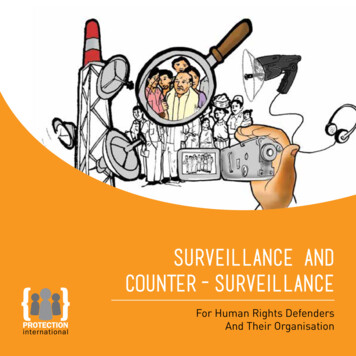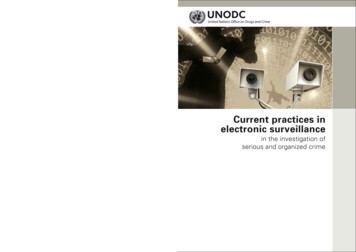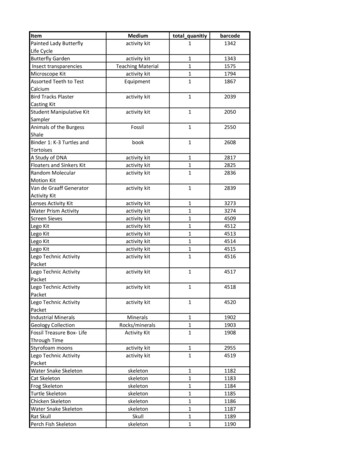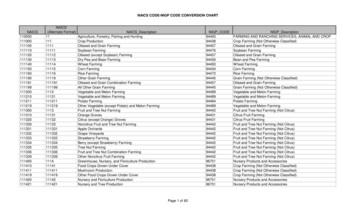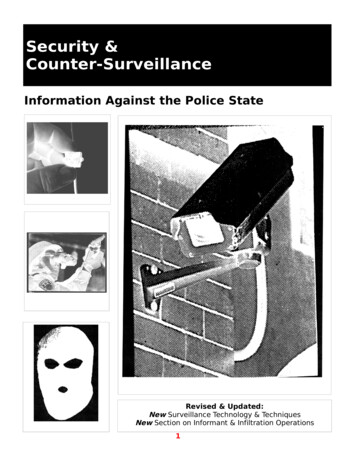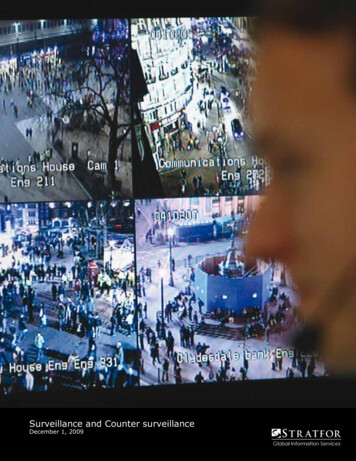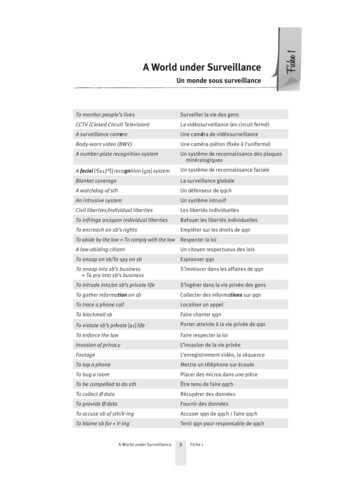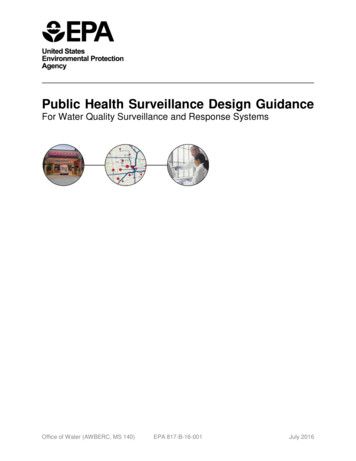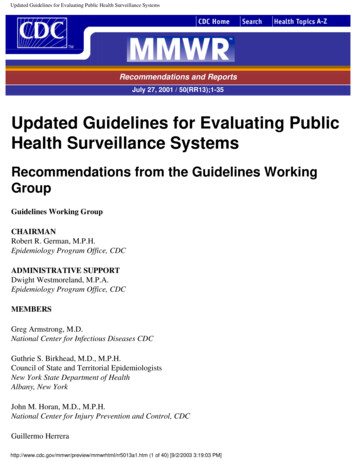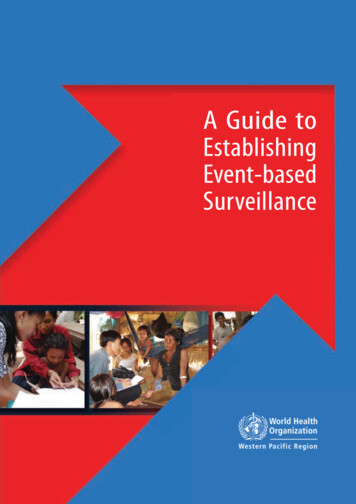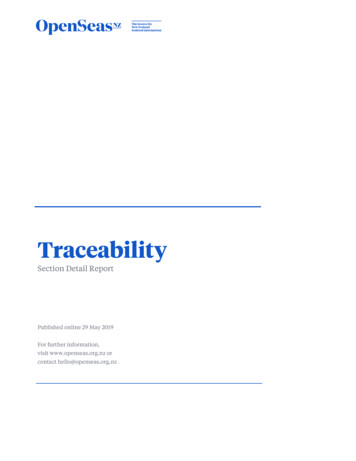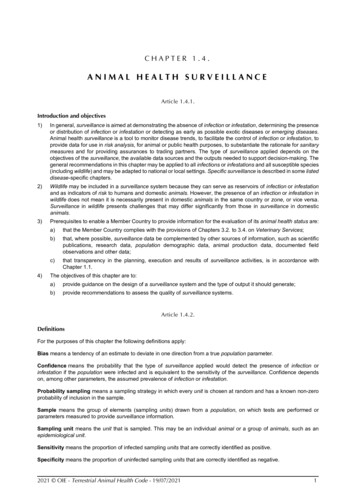
Transcription
CHAPTER 1.4.ANIMAL HEALTH SURVEILLANCEArticle 1.4.1.Introduction and objectives1)In general, surveillance is aimed at demonstrating the absence of infection or infestation, determining the presenceor distribution of infection or infestation or detecting as early as possible exotic diseases or emerging diseases.Animal health surveillance is a tool to monitor disease trends, to facilitate the control of infection or infestation, toprovide data for use in risk analysis, for animal or public health purposes, to substantiate the rationale for sanitarymeasures and for providing assurances to trading partners. The type of surveillance applied depends on theobjectives of the surveillance, the available data sources and the outputs needed to support decision-making. Thegeneral recommendations in this chapter may be applied to all infections or infestations and all susceptible species(including wildlife) and may be adapted to national or local settings. Specific surveillance is described in some listeddisease-specific chapters.2)Wildlife may be included in a surveillance system because they can serve as reservoirs of infection or infestationand as indicators of risk to humans and domestic animals. However, the presence of an infection or infestation inwildlife does not mean it is necessarily present in domestic animals in the same country or zone, or vice versa.Surveillance in wildlife presents challenges that may differ significantly from those in surveillance in domesticanimals.3)Prerequisites to enable a Member Country to provide information for the evaluation of its animal health status are:4)a)that the Member Country complies with the provisions of Chapters 3.2. to 3.4. on Veterinary Services;b)that, where possible, surveillance data be complemented by other sources of information, such as scientificpublications, research data, population demographic data, animal production data, documented fieldobservations and other data;c)that transparency in the planning, execution and results of surveillance activities, is in accordance withChapter 1.1.The objectives of this chapter are to:a)provide guidance on the design of a surveillance system and the type of output it should generate;b)provide recommendations to assess the quality of surveillance systems.Article 1.4.2.DefinitionsFor the purposes of this chapter the following definitions apply:Bias means a tendency of an estimate to deviate in one direction from a true population parameter.Confidence means the probability that the type of surveillance applied would detect the presence of infection orinfestation if the population were infected and is equivalent to the sensitivity of the surveillance. Confidence dependson, among other parameters, the assumed prevalence of infection or infestation.Probability sampling means a sampling strategy in which every unit is chosen at random and has a known non-zeroprobability of inclusion in the sample.Sample means the group of elements (sampling units) drawn from a population, on which tests are performed orparameters measured to provide surveillance information.Sampling unit means the unit that is sampled. This may be an individual animal or a group of animals, such as anepidemiological unit.Sensitivity means the proportion of infected sampling units that are correctly identified as positive.Specificity means the proportion of uninfected sampling units that are correctly identified as negative.2021 OIE - Terrestrial Animal Health Code - 19/07/20211
Chapter 1.4.- Animal health surveillanceStudy population means the population from which surveillance data are derived. This may be the same as the targetpopulation or a subset of it.Surveillance system means the use of one or more surveillance components to generate information on the healthstatus of animal populations.Survey means a component of a surveillance system to systematically collect information with a predefined goal on asample of a defined population group, within a defined period.Target population means the population to which conclusions are to be inferred.Test means a procedure used to classify a unit as either positive, negative or suspect with respect to an infection orinfestation.Article 1.4.3.Surveillance systemsIn designing, implementing and assessing a surveillance system, the following components should be addressed inaddition to the quality of Veterinary Services.1.2Design of surveillance systema)PopulationsSurveillance should take into account all animal species susceptible to the infection or infestation in a country,zone or compartment. The surveillance activity may cover all individuals in the population or only some ofthem. When surveillance is conducted only on a subpopulation, inferences to the target population should bejustified based on the epidemiology of the disease and the degree to which the subpopulation isrepresentative of the target population stated.Definitions of appropriate populations should be based on the specific recommendations of the relevantchapters of the Terrestrial Code.b)Timing and temporal validity of surveillance dataThe timing, duration and frequency of surveillance should be determined taking into consideration factorssuch as:–objectives of the surveillance;–biology and epidemiology (e.g. pathogenesis, vectors, transmission pathways, seasonality);–risk of introduction and spread;–husbandry practices and production systems;–disease prevention and control measures (e.g. vaccination, restocking after disinfection);–accessibility of target population;–geographical factors;–environmental factors, including climate conditions.c)Case definitionWhere one exists, the case definition in the relevant chapter of the Terrestrial Code should be used. If theTerrestrial Code does not give a case definition, a case should be defined using clear criteria for each infectionor infestation under surveillance. For wildlife infection or infestation surveillance, it is essential to correctlyidentify and report host animal taxonomy, including genus and species.d)Epidemiological unitThe relevant epidemiological unit for the surveillance system should be defined. To meet the objective ofsurveillance, the sampling unit selected for testing should reflect the defined epidemiological unit.A group of animals may be considered an epidemiological unit because they share a common environmentor because of common management. Usually, an epidemiological unit is a herd or a flock. However, it mayalso be a group of animals in a pen or a group of animals belonging to residents of a village, or a group ofanimals sharing a communal animal handling facility or, in some circumstances, a single animal. Theepidemiological relationship may differ from disease to disease, or even strain to strain of the pathogenicagent.e)ClusteringInfection or infestation in a country, zone or compartment usually clusters rather than being uniformly orrandomly distributed through a population. Clustering may occur at a number of different levels (e.g. a cluster2021 OIE - Terrestrial Animal Health Code - 19/07/2021
Chapter 1.4.- Animal health surveillanceof infected animals within a herd or flock, a cluster of pens in a building, or a cluster of farms in acompartment). Clustering should be taken into account in the design of surveillance activities and consideredin the statistical analysis of surveillance data.f)Diagnostic testsSurveillance involves the use of tests for detection of infection or infestation according to appropriate casedefinitions. Tests used in surveillance may range from clinical observations and the analysis of productionrecords to rapid field and detailed laboratory assays.The performance of a test at the population level (including field observations) may be described in terms ofits sensitivity, specificity and predictive values. These values together with prevalence will have an impact onthe conclusions drawn from surveillance and should be taken into account in the design of surveillancesystems and analysis of surveillance data.Laboratory tests should be chosen in accordance with the relevant chapters of the Terrestrial Manual.g)Analytical methodologiesSurveillance data should be analysed using appropriate methodologies and at the appropriate organisationallevel to facilitate effective decision-making, whether it be for planning disease control interventions ordemonstrating health status.Methodologies for the analysis of surveillance data should be flexible to deal with the complexity of real lifesituations. No single method is applicable in all cases. Different methodologies may be used to accommodatedifferent host species, pathogenic agents, production systems and surveillance systems, and types andamounts of data and information available.The methodology used should be based on the best data sources available. It should also be in accordancewith this chapter, fully documented and, whenever possible, supported by reference to scientific literature andother sources, including expert opinion. Sophisticated mathematical or statistical analyses may be carried outonly when justified by the objectives of the surveillance and the availability and quality of field data.Consistency in the application of different methodologies should be encouraged. Transparency is essential inorder to ensure objectivity and rationality, consistency in decision-making and ease of understanding. Theuncertainties, assumptions made, and the effect of these on the final conclusions should be documented.h)Scope of the surveillance systemWhen designing the surveillance system consideration should be given to the purposes of surveillance andhow the information it generates will be used, the limitations of the information it will generate, includingrepresentativeness of the study population and potential sources of bias as well as the availability of financial,technical and human resources.i)Follow up actionsThe design of the surveillance system should include consideration of what actions will be taken on the basisof the information generated.2.Implementation of the surveillance systema)Diagnostic testsThe sensitivity and specificity values of the tests used should be specified for target species and the methodused to estimate these values should be documented in accordance with the Terrestrial Manual.Samples from a number of animals or units may be pooled and subjected to a testing protocol. The resultsshould be interpreted using sensitivity and specificity values that have been determined or estimated for thatparticular pool size and testing procedure.b)Data collection and managementThe success of a surveillance system is dependent on a reliable process for data collection and management.The process may be based on paper or electronic records. Even where data are collected for non-surveypurposes (e.g. during disease control interventions, inspections for movement control or during diseaseeradication schemes), the consistency and quality of data collection and event reporting in a format thatfacilitates analysis is critical. Software may offer the possibility of extraction of multiple source data foraggregation and analysis. Factors influencing the quality of collected data include:–the distribution of, and communication between, those involved in generating and transferring data fromthe field to a centralised location; this requires effective collaboration among all stakeholders, such asgovernment or non-governmental organisations, and others, particularly for data involving wildlife;–the ability of the data processing system to detect missing, inconsistent or inaccurate data, and toaddress these problems;–maintenance of raw data rather than the compilation of summary data;–minimisation of transcription errors during data processing and communication.2021 OIE - Terrestrial Animal Health Code - 19/07/20213
Chapter 1.4.- Animal health surveillance3.Quality assuranceSurveillance systems should be subjected to periodic auditing to ensure that all components function and provideverifiable documentation of procedures and basic checks to detect deviations of procedures from those specifiedin the design, in order to implement appropriate corrective actions.Article 1.4.4.Surveillance methodsSurveillance systems routinely use data collected by probability-based or non-probability-based methods, either aloneor in combination. A wide variety of surveillance sources may be available. These vary in their primary purpose and thetype of surveillance information they are able to provide.1.Disease reporting systemsDisease reporting systems are based on reporting of animal health-related events to the Veterinary Authority. Dataderived from disease reporting systems can be used in combination with other data sources to substantiate claimsof animal health status, to generate data for risk analysis or for early warning and response. Effective laboratorysupport is an important component of any reporting system. Reporting systems relying on laboratory confirmationof suspected clinical cases should use tests that have high specificity as described in the Terrestrial Manual.Whenever the responsibility for disease reporting falls outside the scope of the Veterinary Authority, for examplehuman cases of zoonotic diseases or infections or infestations in wildlife, effective communication and data sharingshould be established between the Veterinary Authority and other relevant authorities.Participatory surveillance methods may be useful to collect epidemiological data that can support disease reportingsystems.2.SurveysIn addition to the principles in Article 1.4.3., the following should be considered when planning, implementing andanalysing surveys.Surveys may be conducted on the entire target population (i.e. a census) or on a sample.The sources of data should be fully described and should include a detailed description of the sampling strategyused for the selection of units for testing. Also, consideration should be given to any biases that may be inherentin the survey design.a)Survey designThe target and study populations should first be clearly defined. Depending on the design of the survey,appropriate sampling units should be defined for each stage.The design of the survey will depend on the knowledge of the size, structure and distribution of the population,the epidemiology of the infection or infestation and the resources available.Data on the size, structure and distribution of wildlife populations often do not exist. However, they should beestimated to the extent possible before the survey is designed. Expert opinion can be sought in the gatheringand interpretation of such population data. Historical population data should be updated since these may notreflect current populations.b)Samplingi)ObjectiveThe objective of sampling from a population is to select a subset of units from the population of interestwith respect to the objective of the study, taking into account practical constraints imposed by different42021 OIE - Terrestrial Animal Health Code - 19/07/2021
Chapter 1.4.- Animal health surveillanceenvironments and production systems so that data from the study population can be extrapolated to thetarget population.When selecting units from a target population to have a representative sample, probability-basedsampling, such as a simple random selection, should be used.Where probability-based sampling is not feasible, non-probability-based methods may be applied andshould provide the best practical chance of generating a sample that can be considered asrepresentative of the target population.When the objective of non-probability-based sampling is to maximise the likelihood of detection of theinfection or infestation, this type of sampling may not be representative of the target population.When using non-probability-based sampling, representativeness can only be achieved if risk factors areweighted and the weights are supported by relevant scientific evidence capturing the relative differencesin risk and proportion between the study population and the target population.The sampling method used at all stages should be fully documented.ii)Sample sizeIn surveys conducted to demonstrate the presence or absence of an infection or infestation the methodused to calculate sample size depends on the size of the population, the design of the survey, theexpected prevalence and possible clustering, the level of confidence desired of the survey results andthe performance of the tests used.In addition, for surveys designed to estimate a parameter (e.g. prevalence) consideration should begiven to the desired precision of the estimate.iii)Sample selection––3.Probability-based sampling methods, such as:–simple random selection;–cluster sampling;–stratified sampling;–systematic sampling;–risk-based sampling.Non-probability-based sampling methods, depending on:–convenience;–expert choice;–quota;–risk.Risk-based methodsSurveillance activities targeting selected subpopulations in which an infection or infestation is more likely to beintroduced or found, or more likely to spread, or cause other consequences and contribute to early detection,freedom claims, disease control activities, and estimation of prevalence. Risk-based methods can be used for bothprobability-based and non-probability-based sampling methods and data collection. The effect of the selection (i.e.its impact on probability of detection) should be estimated.Risk-based methods should be based on a risk assessment and are useful to optimise the use of surveillanceresources.4.Ante-mortem and post-mortem inspectionsInspection of animals at slaughterhouses/abattoirs may provide valuable surveillance data. The sensitivity andspecificity of slaughterhouse/abattoir inspections for detecting the presence of specified diseases will be influencedby:a)clinical and pathological signs;b)the training, experience and number of the inspection staff;c)the extent to which the Competent Authority is involved in the supervision of ante-mortem and post-morteminspections, including reporting systems;d)the quality of construction of the slaughterhouse/abattoir, speed of the slaughter chain, lighting quality, etc.;ande)independence of the inspection staff.Slaughterhouse/abattoir inspections are likely to provide good coverage for particular age groups and geographicalareas only. Slaughterhouse/abattoir surveillance data may only be representative of a particular subpopulation2021 OIE - Terrestrial Animal Health Code - 19/07/20215
Chapter 1.4.- Animal health surveillance(e.g. only animals of a particular class and age are likely to be slaughtered for human consumption in significantnumbers). Such limitations should be recognised when analysing surveillance data.The usefulness of data generated by slaughterhouse/abattoir inspections is dependent on effective animaltraceability that relates animals to their herd or flock or locality of origin.Post-mortem inspection conducted in locations other than slaughterhouses/abattoirs (e.g. rendering plants, huntingplaces) may also provide valuable surveillance data.5.Surveillance of sentinel unitsSurveillance of sentinel units involve the identification and regular testing of one or more animals of known healthor immune status in a specified geographical location to detect the occurrence of infection or infestation. Sentinelunits provide the opportunity to target surveillance depending on the risk of introduction or re-emergence, likelihoodof infection or infestation, cost and other practical constraints. Sentinel units may provide evidence of freedom from,or distribution of, disease, infection or infestation.6.Clinical surveillanceClinical observations of animals in the field are an important source of surveillance data. The sensitivity andspecificity of clinical observations are highly dependent on the criteria used to define a suspected case. In order toallow comparison of data, the case definition should be standardised. Awareness and training of potential fieldobservers, including animal keepers, in the application of the case definition and reporting are important. Ideally,both the number of positive observations and the total number of observations should be recorded.7.Syndromic surveillanceSystematic analysis of health data, including morbidity and mortality rates, production records and otherparameters can be used to generate signals that may be indicative of changes in the occurrence of infection orinfestation.8.Other useful dataa)Data generated by control programmes and health schemesWhile focusing on the control or eradication of specific infections or infestations, control programmes or healthschemes can be used to generate data that can contribute to other surveillance objectives.b)Laboratory investigation recordsLaboratory investigation records may provide useful data for surveillance, in particular for retrospectivestudies. Multiple sources of data such as national, accredited, university and private sector laboratoriesshould be integrated in order to increase the coverage of the surveillance system.Valid analysis of data from different laboratories depends on the existence of quality control and qualityassurance systems, including standardised diagnostic procedures and standardised methods for datarecording and interpretation as well as a mechanism to ensure the traceability of specimens to herd or flockor locality of origin.c)Biological specimen banksSpecimen banks consist of stored specimens, gathered through representative sampling or opportunisticcollection. Specimen banks may contribute to retrospective studies, including providing support for claims ofhistorical freedom from disease, infection or infestation, and may allow certain studies to be conducted morequickly and at lower cost than other approaches.d)Wildlife dataSpecimens for surveillance from wildlife may be available from sources such as hunters and trappers,road-kills, wild animal meat markets, sanitary inspection of hunted animals, morbidity and mortalityobservations by the general public, wildlife rehabilitation centres, wildlife biologists and wildlife agency fieldpersonnel, farmers and other landholders, naturalists and conservationists. Wildlife data such as census data,trends over time, and reproductive success can be used in a manner similar to farm production records forepidemiological purposes.e)Public health dataFor zoonotic diseases public health data may be an indicator of a potential change in the animal health status.The Veterinary Authority should coordinate with human health authorities and share data for integration intospecific surveillance systems.f)Environmental dataRelevant environmental data such as rainfall, temperature, extreme climatic events, presence andabundance of potential vectors as described in Chapter 1.5., should also be integrated into the surveillancesystem.62021 OIE - Terrestrial Animal Health Code - 19/07/2021
Chapter 1.4.- Animal health surveillanceg)9.Additional supporting data such as:i)data on the epidemiology of the infection or infestation, including host population distribution;ii)data on animal movements, including transhumance and natural wildlife migrations;iii)trading patterns for animals and animal products;iv)national animal health regulations, including information on compliance and effectiveness;v)history of imports of potentially infected material;vi)biosecurity in place; andvii)the risk of introduction of infection or infestation.Combination and interpretation of surveillance resultsDepending on the objective of surveillance, the combination of multiple sources of data may provide an indicationof the overall sensitivity of the system and may increase the confidence in the results. The methodology used tocombine the evidence from multiple data sources should be scientifically valid, and fully documented, includingreferences to published material.Surveillance information gathered from the same country, zone or compartment at different times may providecumulative evidence of animal health status. Repeated surveys may be analysed to provide a cumulative level ofconfidence. However, the combination of data collected over time from multiple sources may be able to achieve anequivalent level of confidence.Analysis of surveillance information gathered intermittently or continuously over time should, where possible,incorporate the time of collection of the information to take the decreased value of older information into account.The sensitivity and specificity of tests used and completeness of data from each source should also be taken intoaccount for the final overall confidence level estimation.In assessing the efficiency of the surveillance system based on multiple sources, the Veterinary Authority shouldconsider the relative contribution of each component to the overall sensitivity, while considering the primaryobjective of each surveillance component.Results from animal health surveillance systems are subject to one or more potential biases. When assessing theresults, care should be taken to identify potential biases that can inadvertently lead to an over-estimate or anunder-estimate of the parameters of interest.Article 1.4.5.Early warning systemsAn early warning system is essential for the timely detection, reporting and communication of occurrence, incursion oremergence of diseases, infections or infestations and is an integral component of emergency preparedness. It shouldbe under the control of the Veterinary Authority and should include the following:1)appropriate access to, and authority over, the target animal populations by the Veterinary Services;2)access to laboratories capable of diagnosing and differentiating relevant infections or infestations;3)training and awareness programmes for veterinarians, veterinary paraprofessionals, animal owners or keepers andothers involved in handling animals at the farm or other places where they are kept during their transport or at theslaughterhouse/abattoir, for detecting and reporting unusual animal health incidents;4)a legal obligation by veterinarians and other relevant stakeholders to report suspected cases or cases of notifiablediseases or emerging diseases to the Veterinary Authority, including the description of the findings;5)epidemiological investigations of suspected cases and cases conducted by the Veterinary Services in order toconfirm cases and to acquire accurate knowledge of the situation for further action.All suspected case investigations should provide a result, either positive or negative. Criteria should be establishedin advance for a case definition. Confirmation can be made on clinical and post-mortem grounds, epidemiologicalinformation, laboratory test results or a combination of these, in accordance with relevant articles of the TerrestrialCode or Terrestrial Manual;6)effective systems of communication between the Veterinary Authority and relevant stakeholders;7)a national chain of command.2021 OIE - Terrestrial Animal Health Code - 19/07/20217
Chapter 1.4.- Animal health surveillanceArticle 1.4.6.Surveillance for freedom from a disease, infection or infestation1.Demonstration of freedomA surveillance system to demonstrate freedom from a disease, infection and infestation should meet the following,in addition to the general principles outlined in Article 1.4.3. It should also take into account any preventionmeasures in place such as vaccination in accordance with this chapter and Chapter 4.18.Freedom implies the absence of infection or infestation in an animal population in the country, zone orcompartment. Scientific methods cannot provide absolute certainty of this absence. Therefore, demonstratingfreedom, except for historical freedom, involves providing sufficient evidence to demonstrate to a desired level ofconfidence that infection or infestation with a specified pathogenic agent, if present, is present in less than aspecified proportion of the population.However, finding evidence of infection or infestation at any prevalence in the target population automaticallyinvalidates any freedom claim unless otherwise stated in the relevant chapters of the Terrestrial Code.It can be difficult to collect sufficient epidemiological data to demonstrate absence of infection or infestation in wildanimal populations. In such circumstances, a range of supporting evidence should be used to make thisassessment. The consequences of the presence of infection or infestation in wildlife in the same country or zoneon the status of domestic animals should be assessed in each situation, as described in the relevant chapters ofthe Terrestrial Code.Evidence from probability and non-probability risk-based data collection may increase the sensitivity of thesurveillance.2.Requirements to declare a country or a zone free from an infection or infestationa)b)Prerequisites, unless otherwise specified in the relevant chapters of the Terrestrial Code:i)the infection or infestation has been a notifiable disease;ii)an early warning system has been in place for all relevant species;iii)measures to prevent the introduction of the infection or infestation have been in place: in particular, theimportations or movements of commodities into the country or zone have been carried out in accordancewith the relevant chapters of the Terrestrial Code;iv)the infection or infestation is not known to be established in wildlife within the country or zone.Historical freedomUnless otherwise specified in the relevant chapter of the Terrestrial Code, a country or zone may beconsidered free without formally applying a pathogen-specific surveillance programme when:i)c)3.8for at least the past 10 years:–no vaccination against the disease has been carried out;–the prerequisites listed in point (a) are complied with;ii)the pathogenic agent is likely to produce identifiable clinical or pathological signs in susceptible animals;iii)for at least 25 years there has been no occurr
Surveillance systems routinely use data collected by probability-based or non-probability-based methods, either alone or in combination. A wide variety of surveillance sources may be available. These vary in their primary purpose and the type of surveillance information they are able to provide. 1. Disease reporting systems
